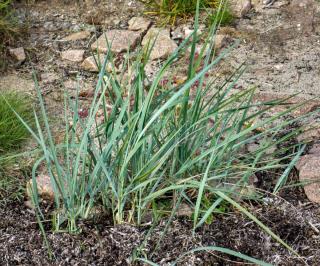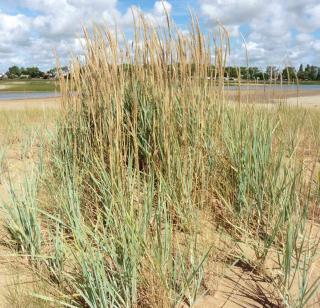

Sand ryegrass key facts
Botanical name – Leymus arenarius, Elymus arenarius
Common name – sand ryegrass, lyme grass
Family – Poaceae
Type – grass
Bearing – arched
Height – 4 to 5 feet (1.20 m to 1.50 m)
Planting density – 4 to 6 plants per sq. yard (m²)
Exposure – full sun Soil – any type
Flowering – from June to August
Leymus arenarius owes its name to its strong resemblance to rye, especially the seed panicles. Since it quickly becomes invasive, it’s important to take a few precautions when planting it. Nonetheless, this is the perfect plant if your goal is to cover or stabilize an embankment. In addition, its blueish foliage will add an original touch of color to your garden.
Leymus arenarius can cope with any type of soil. It does, however, require full sun exposure to truly thrive, though part sun is possible. For it to settle in faster, we recommend planting in fall, following these steps:
 dig a hole 6 to 8 inches deep;
dig a hole 6 to 8 inches deep;Smart tip : sand rye grass is a grass that might quickly become invasive if it’s planted in sandy soil. To prevent this issue, you’ve got two option:
Both techniques work well to contain roots and control spread.
As is the case for many grasses, sand ryegrass requires nearly no care at all. All you’ve got to do is cut back the clump at the beginning of spring to renew leaves with new growth.
To multiply a clump of Leymus arenariusjust separate it in fall:
Leymus arenarius is a resistant grass. It thus resists all diseases and pests.
 As mentioned at the beginning of the article, sand rye grass is ideal for embankments: whether you simply want to cover it or stabilize it against erosion. However, another idea is to use it in a flower bed or along edges, as long as you remember to set limits upon planting so it won’t spread.
As mentioned at the beginning of the article, sand rye grass is ideal for embankments: whether you simply want to cover it or stabilize it against erosion. However, another idea is to use it in a flower bed or along edges, as long as you remember to set limits upon planting so it won’t spread.
On top of these uses, its capacity to resist drought and sea spray make it an excellent choice for a coastal garden.
Regarding companion plants, you might want to look into the following for your Leymus arenarius : other grasses and perennials such as veronica or red heuchera, the colors of which pair well together.
If you like creating dried flower bouquets, you’ll appreciate knowing that just like rye, sand ryegrass is very well suited to this art.